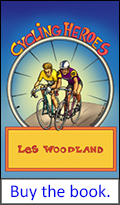

A Criterium Primer
By Todd Scheske, PCG elite coach
Back to list of our training and coaching essays

Les Woodland's book Cycling Heroes: The Golden Age is available as an audiobook here. For the print and Kindle eBook versions, just click on the Amazon link on the right.
Todd Scheske writes:
How to Race a Criterium:
Criteriums, or “crits” as they’re often referred to, are short course races from 800 meters to 5 kilometers in length, with race distances usually from 20 to 100 kilometers (for elite level). Crits offer high speeds and are perfect spectator events, with great opportunities for some exciting action. While newer racers may find them a bit intimidating at first, by keeping a few things in mind they needn’t avoid these really fun and exciting types of races.
One of the golden rules I use for riding a criterium is to not chase unless you absolutely have to. Attack and counter-attack instead. Use features on the course to help create distance from the pack and/or gain ground on rivals in the break; things like a tight corner or a small hill can help to amplify the attack you might make as hesitation from the field results in you opening an instant gap. The field also tends to line out more during such times, so there are fewer people up front to respond to the attack right away. The break may also be going a steadier pace through these features, which allows you to get across more quickly with a short burst. If you wait too long after a break to go, you might have to co-opt a few others to chase a bit to get close enough to counter and get across, but make sure you aren’t the biggest engine in the chase or you won’t be able to counter once you’re close.

Skilled criterium riders use corners to their advantage
Attacks and counter-attacks are what split the field and create breaks, but the first attack almost never makes it. Everyone is fresh then, and most of the time it comes back. Of course there are rare times when it does stick, but the probability is low, so it’s usually better to hedge your bets and join or launch a counter attack. You might try to make the first attack if it seems the field is tentative, but even if your attack works, leave something in the tank for the counter until you have a large gap. Keep in mind that the first fifteen minutes of the race can be some of the fastest and hardest. Be patient.
Be aware of the “accordion effect” in the pack. Tight turns and the features above that you use for attacking also bunch up the riders at the back of the field, who then accelerate hard again after the turn to make up for lost speed. Being at the back and subject to this effect can blow you up; it takes a lot more energy to ride the back like that than it does to ride further forward. Unfortunately, tentative riders usually end up toward the back and become a self-fulfilling prophesy.
The most important thing to remember in a criterium is to relax; flow with the race and the course. Criteriums are super fun to race, but it does take some time to develop the skills for success. Be patient and keep at it!
Todd Scheske is a USA Cycling Level 1 coach and a category 1 cyclist. He has won several masters national medals, state road championships, and regional victories. Over the past twenty years he founded four different elite cycling teams and served as their program director and team director, while also promoting bike safety and healthy lifestyles to youth in community programs. He runs a successful junior program and produces a USA Cycling Talent ID camp. Todd can be contacted directly through www.PeaksCoachingGroup.com.
.








